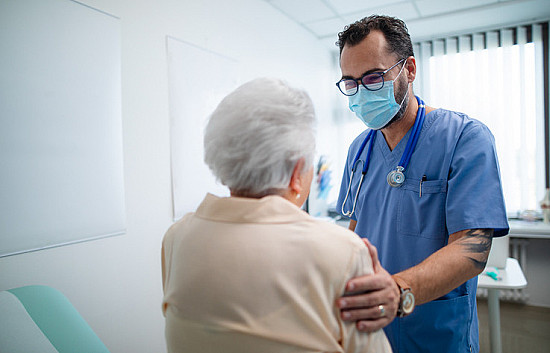If you’re a trauma survivor or dislike physical touch, health care visits may be hard.

Physical touch has long been linked to the healing process of medicine. During physical exams, the laying on of hands — broadly known as therapeutic touch — offers many clues to help health practitioners decide on the best course of treatment.
Yet therapeutic touch has begun to fall out of practice, as doctors tap away at electronic medical records during patient visits and diagnostic tools like CT scans and echocardiograms pull time and energy away from the bedside. Whether or not you view this as a loss may depend on your feelings and life experiences — particularly if you’re a trauma survivor. Here’s why therapeutic touch matters during medical visits, and how to help strike a good balance to get the care you need.
Why is touch helpful to good health care?
The idea that touch can be therapeutic is more than a theory. Physicians use touch as a way of comforting a patient, as well as in physical exams to detect clues to possible abnormalities: a tender upper right abdomen pointing toward a gallstone, let’s say, or a lump that might signal cancer. While listening to your heart, they may place a hand on your back to listen for murmurs. Taps on your knee with a reflex hammer assess your nerves. In many cases, without a physical exam, clues about the underlying health issue could easily be missed.
While many people report feeling reassured by a doctor’s touch, some forms of touch are more charged than others. If you have certain health concerns, your doctor may suggest doing an exam of more private areas, such as a rectal or breast exam. When doctors forego components of a physical exam, some people may be dissatisfied and may worry something important could have been missed. Others may feel relief.
Therapeutic touch is used by some nurses and many alternative or integrative health practitioners. A few examples are spinal manipulation performed by chiropractors, and body work like reiki (which requires light touch or no direct physical touch) or massage.
What if physical touch is hard for you to tolerate?
Not everyone welcomes touch during medical visits. Some people feel uncomfortable with the invasion of their personal space, or some unease depending on their health practitioner’s gender.
Survivors of trauma, including sexual assault, have higher rates of anxiety and are less likely to engage with the health care system than the general population. Pelvic exams in particular can seem unbearable to some people. An uncomfortable or traumatizing visit to the doctor can turn the health care system into an intimidating entity and prevent people from receiving the care they need.
If you recognize yourself here, there are actions you can take to make health experiences easier to handle.
How can you get the health care you need?
Often, the physical exam is important for the physician to make the right diagnosis. While you are always able to completely refuse any recommendation, there may be ways your doctor can make the experience more comfortable to ensure you’re getting the best assessment possible.
Fortunately, more and more physicians are trained in trauma-informed care. Trauma-informed care assumes that all patients might have a history of trauma, and encourages health practitioners to work to create a safe space for everyone they see. This might mean asking you up front how they can make the encounter more comfortable, and fully explaining each step of the physical exam.
Even without a history of trauma, you may have cultural or personal reasons for wanting to avoid touch that are valid and worthy of your medical team’s attention. For example, I’m still taken aback if someone offers me a handshake at the beginning of a health visit. I’m out of practice, despite our days of social distancing ending.
If you’re nervous about an upcoming visit, here are ways to help make it a more comfortable experience:
- Mention your concern to the nurse or medical assistant as you are getting checked into the exam room, or tell the physician when they arrive. Remember that you do not have to go into details that you do not want to share. Just indicating that you have a preference about physical touch can help the physician understand your needs and work with you to help you feel safe.
- Ask your provider to explain all the steps involved in the physical exam before it starts, so there are no surprises. Many doctors will do this even if not asked.
- If you’d prefer a chaperone, such as a medical assistant or a friend or family member, to be present during any or all parts of the exam, it’s fine to ask for one. This is a standard practice for particularly intimate exams like a pelvic exam.
If therapeutic touch by a doctor or other health practitioner is not actually therapeutic for you, I encourage you to communicate with your providers. They should listen carefully to your needs to create a nonjudgmental and trusting relationship.
